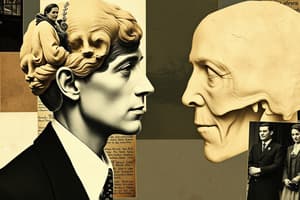Podcast
Questions and Answers
What is latent learning as demonstrated by Tolman's experiments with rats?
What is latent learning as demonstrated by Tolman's experiments with rats?
- Learning that occurs only when rewards are consistently provided.
- Learning that involves direct instruction from a trainer.
- Learning without reinforcement that is demonstrated when a reward is introduced. (correct)
- Learning that is immediately observable through behavior.
What is one crucial element of the gestalt approach to problem solving?
What is one crucial element of the gestalt approach to problem solving?
- Reconstructing the understanding of a problem to find a solution. (correct)
- Understanding the problem through prior experiences solely.
- Mechanistic analysis of each step in a problem.
- Following a predetermined series of steps to reach a solution.
How did the unreinforced rats perform when a food reward was introduced after several trials?
How did the unreinforced rats perform when a food reward was introduced after several trials?
- They became confused and failed to find the food at all.
- They demonstrated quicker navigation through the maze, similar to the rewarded group. (correct)
- They continued to wander aimlessly in the maze.
- Their speed in navigating the maze decreased due to distraction.
What is an insight problem characterized by?
What is an insight problem characterized by?
Which statement best describes the term 'cognitive map' as used in Tolman's research?
Which statement best describes the term 'cognitive map' as used in Tolman's research?
What is the purpose of shaping in behavior modification?
What is the purpose of shaping in behavior modification?
Which of the following is an example of a primary reinforcer?
Which of the following is an example of a primary reinforcer?
What distinguishes secondary reinforcers from primary reinforcers?
What distinguishes secondary reinforcers from primary reinforcers?
Which reinforcement schedule involves providing reinforcement every time a behavior is displayed?
Which reinforcement schedule involves providing reinforcement every time a behavior is displayed?
What happens to a behavior when reinforcement stops?
What happens to a behavior when reinforcement stops?
Which of the following is an example of a schedule of reinforcement that is NOT continuous?
Which of the following is an example of a schedule of reinforcement that is NOT continuous?
In shaping, after reinforcing a response that closely resembles the desired behavior, what is the next step?
In shaping, after reinforcing a response that closely resembles the desired behavior, what is the next step?
What is meant by intermittent reinforcement?
What is meant by intermittent reinforcement?
What is the expected outcome when a reinforcer is stopped in a fixed interval schedule?
What is the expected outcome when a reinforcer is stopped in a fixed interval schedule?
What occurs during positive punishment?
What occurs during positive punishment?
Which term best describes the process of making a behavior automatic through repetition?
Which term best describes the process of making a behavior automatic through repetition?
In which of the following modeling steps must the learner memorize the actions of the model?
In which of the following modeling steps must the learner memorize the actions of the model?
What type of model describes a fictional character demonstrating behavior?
What type of model describes a fictional character demonstrating behavior?
Which factor is essential for a learner to be motivated to imitate a behavior observed in a model?
Which factor is essential for a learner to be motivated to imitate a behavior observed in a model?
What is the main goal of positive punishment in a video game setting?
What is the main goal of positive punishment in a video game setting?
Which of the following correctly defines observational learning?
Which of the following correctly defines observational learning?
What effect does vicarious punishment have on a learner's behavior?
What effect does vicarious punishment have on a learner's behavior?
According to Bandura's Bobo Doll Experiment, when children observe a model who is punished for aggressive behavior, what are they most likely to do?
According to Bandura's Bobo Doll Experiment, when children observe a model who is punished for aggressive behavior, what are they most likely to do?
What percentage of child abuse victims are reported to become abusive parents?
What percentage of child abuse victims are reported to become abusive parents?
What does research suggest about the relationship between violent media exposure and aggression in children?
What does research suggest about the relationship between violent media exposure and aggression in children?
Which factor is NOT commonly associated with aggressive behavior in children, according to the content?
Which factor is NOT commonly associated with aggressive behavior in children, according to the content?
In the context of cognitive learning theory, can learning occur without any form of punishment or reward?
In the context of cognitive learning theory, can learning occur without any form of punishment or reward?
What is the definition of Classical Conditioning?
What is the definition of Classical Conditioning?
What is one of the main consequences for children who witness their parents dealing with anger through violence?
What is one of the main consequences for children who witness their parents dealing with anger through violence?
Which term refers to a stimulus that automatically elicits a response?
Which term refers to a stimulus that automatically elicits a response?
What key aspect did Ferguson's research highlight about the link between violent media and aggression?
What key aspect did Ferguson's research highlight about the link between violent media and aggression?
What happens to a neutral stimulus after it is repeatedly paired with an unconditioned stimulus?
What happens to a neutral stimulus after it is repeatedly paired with an unconditioned stimulus?
Which of the following statements is true about the unconditioned response (UCR)?
Which of the following statements is true about the unconditioned response (UCR)?
In Classical Conditioning, what is the response caused by the conditioned stimulus (CS) called?
In Classical Conditioning, what is the response caused by the conditioned stimulus (CS) called?
Which psychologist is famous for his research on Classical Conditioning?
Which psychologist is famous for his research on Classical Conditioning?
What is the role of the neutral stimulus (NS) in the process of Classical Conditioning?
What is the role of the neutral stimulus (NS) in the process of Classical Conditioning?
What key aspect distinguishes an unconditioned stimulus (UCS) from a conditioned stimulus (CS)?
What key aspect distinguishes an unconditioned stimulus (UCS) from a conditioned stimulus (CS)?
What is an unconditioned stimulus in classical conditioning?
What is an unconditioned stimulus in classical conditioning?
Which of the following principles is essential for effective classical conditioning?
Which of the following principles is essential for effective classical conditioning?
What is meant by stimulus discrimination?
What is meant by stimulus discrimination?
What occurs during stimulus generalization?
What occurs during stimulus generalization?
What happens when the conditioned stimulus is presented repeatedly without the unconditioned stimulus?
What happens when the conditioned stimulus is presented repeatedly without the unconditioned stimulus?
Which of the following statements about the timing of the CS and UCS is false?
Which of the following statements about the timing of the CS and UCS is false?
How do Pavlov's dogs demonstrate stimulus discrimination?
How do Pavlov's dogs demonstrate stimulus discrimination?
Which of the following best describes an unconditioned response?
Which of the following best describes an unconditioned response?
Flashcards
Learning
Learning
A relatively permanent change in behavior that results from experience or practice.
Classical Conditioning
Classical Conditioning
Learning to involuntarily react to a stimulus other than the one that initially triggered the response.
Unconditioned Stimulus (UCS)
Unconditioned Stimulus (UCS)
The stimulus that naturally elicits a reflexive response.
Unconditioned Response (UCR)
Unconditioned Response (UCR)
Signup and view all the flashcards
Neutral Stimulus (NS)
Neutral Stimulus (NS)
Signup and view all the flashcards
Conditioned Stimulus (CS)
Conditioned Stimulus (CS)
Signup and view all the flashcards
Conditioned Response (CR)
Conditioned Response (CR)
Signup and view all the flashcards
What is classical conditioning?
What is classical conditioning?
Signup and view all the flashcards
Stimulus Discrimination
Stimulus Discrimination
Signup and view all the flashcards
Stimulus Generalization
Stimulus Generalization
Signup and view all the flashcards
Extinction
Extinction
Signup and view all the flashcards
Latent Learning
Latent Learning
Signup and view all the flashcards
Cognitive Map
Cognitive Map
Signup and view all the flashcards
Insight
Insight
Signup and view all the flashcards
Insight Problems
Insight Problems
Signup and view all the flashcards
Reconstruction
Reconstruction
Signup and view all the flashcards
Variable Ratio Schedule Extinction
Variable Ratio Schedule Extinction
Signup and view all the flashcards
Fixed Interval Schedule Extinction
Fixed Interval Schedule Extinction
Signup and view all the flashcards
Positive Punishment
Positive Punishment
Signup and view all the flashcards
Negative Punishment
Negative Punishment
Signup and view all the flashcards
Skill Learning (Motor Learning)
Skill Learning (Motor Learning)
Signup and view all the flashcards
Observational Learning (Modeling)
Observational Learning (Modeling)
Signup and view all the flashcards
Live Model
Live Model
Signup and view all the flashcards
Verbal Instructional Model
Verbal Instructional Model
Signup and view all the flashcards
Shaping
Shaping
Signup and view all the flashcards
Primary Reinforcers
Primary Reinforcers
Signup and view all the flashcards
Secondary Reinforcers
Secondary Reinforcers
Signup and view all the flashcards
Continuous Reinforcement
Continuous Reinforcement
Signup and view all the flashcards
Partial Reinforcement
Partial Reinforcement
Signup and view all the flashcards
Fixed Interval
Fixed Interval
Signup and view all the flashcards
Variable Interval
Variable Interval
Signup and view all the flashcards
Vicarious Punishment
Vicarious Punishment
Signup and view all the flashcards
Vicarious Punishment and Observational Learning
Vicarious Punishment and Observational Learning
Signup and view all the flashcards
Bandura's Bobo Doll Experiment
Bandura's Bobo Doll Experiment
Signup and view all the flashcards
Antisocial Effects of Observational Learning
Antisocial Effects of Observational Learning
Signup and view all the flashcards
Media Violence and Aggression
Media Violence and Aggression
Signup and view all the flashcards
Other Factors Influencing Aggression
Other Factors Influencing Aggression
Signup and view all the flashcards
Cognitive Learning Theory
Cognitive Learning Theory
Signup and view all the flashcards
Learning without Punishment or Reward
Learning without Punishment or Reward
Signup and view all the flashcards
Study Notes
Learning: A Definition
- Learning is a permanent behavioral change from experience or practice.
Types of Learning
- Behavior modification: Classical conditioning, operant conditioning, skill learning, observational learning, cognitive learning theory.
Classical Conditioning
- Learning to associate an involuntary response with a new stimulus.
- "Learning to make an involuntary response to a stimulus other than the original, natural stimulus that normally produces the response" (Ciccarelli & White, 2021, p. 194).
- Classical conditioning was investigated by Pavlov (late 19th-early 20th century) and later John B. Watson (20th century)
Elements of Classical Conditioning
- Unconditioned Stimulus (UCS): A stimulus that produces a reflexive response automatically.
- Unconditioned Response (UCR): The natural, automatic response to a UCS (e.g., salivating to food).
- Neutral Stimulus (NS): A stimulus that initially does not elicit the UCR.
- Conditioned Stimulus (CS): An initially neutral stimulus paired with the UCS, eventually eliciting the CR.
- Conditioned Response (CR): A learned response to the CS.
Classical Conditioning: In Action
- During pairing, a NS is repeatedly presented with the UCS
- The NS eventually becomes the CS eliciting the CR
- The CS stimulus elicits a response, called the CR
- There are principles of Conditioning, like order of presentation, timing, and repetition which need to be considered
Principles of Classical Conditioning
- CS must precede the UCS
- The time gap between CS and UCS needs to be short
- CS needs to be attention capturing
- There are exceptions
Stimulus Discrimination
- Different response to different stimuli (similar stimuli).
- Pavlov's dogs distinguished between the sound leading to food and other sounds (like a bell).
- Organism learns to distinguish similar stimuli
Stimulus Generalization
- Similar stimuli tend to evoke similar responses.
- The more similar a stimulus is to the CS, the more likely a CR is.
Extinction
- The decrease of a CR when the UCS is no longer presented with the CS.
- The CR gradually disappears.
- Spontaneous recovery is the return of a CR after a rest period.
Higher-Order Conditioning
- A previously conditioned stimulus (first-order CS) acts as a new UCS to establish a new conditioned stimulus
Operant Conditioning
- Consequences influence future behavior.
- Reinforcement increases the likelihood of a behavior, punishment decreases it.
Types of Reinforcement and Punishment
- Positive Reinforcement: Adding a desirable stimulus to increase behavior (e.g., praise for good grades).
- Negative Reinforcement: Removing an undesirable stimulus to increase behavior (e.g., taking aspirin to remove a headache).
- Positive Punishment: Adding an undesirable stimulus to decrease behavior (e.g., a speeding ticket for speeding).
- Negative Punishment: Removing a desirable stimulus to decrease behavior (e.g., taking away a teenager's phone).
Shaping
- Rewarding successive approximations of desired behavior (making a behavior more accurate).
- Break down complex behaviors into smaller, achievable steps, reinforcing each.
Primary and Secondary Reinforcers
- Primary reinforcers: Innate reinforcing qualities (e.g., food, water).
- Secondary reinforcers: Gain reinforcing qualities through association with primary reinforcers (e.g., money, grades).
Reinforcement Schedules
- Continuous reinforcement: Reinforce every desired response.
- Partial reinforcement: Reinforce some, but not all, desired responses. (Fixed interval, variable interval, fixed ratio, variable ratio schedules)
- The patterns of response rate varies depending on type,
Extinction (for operant conditioning)
- If reinforcement stops, behavior stops
- Variable ratio schedule yields slow extinction rate, fixed interval yields fast high rate
Behavior Modification: Decreasing Behavior
- Positive Punishment: Adding an undesirable stimulus to decrease an undesired behavior.
- Negative Punishment: Removing a desirable stimulus to decrease an undesired behavior
Skill Learning (Motor Learning)
- Repeatedly performing to make behavior automatic.
- Examples include activities like knitting, driving, and biking
Observational Learning
- Learning through observing others.
- Includes imitating (modeling).
- People can serve as models in any of the following ways: Live, verbal and symbolic
Steps in the Modeling Process
- Attention (paying attention to the model).
- Retention (remembering the model's behavior).
- Reproduction (ability to reproduce the modeled behavior).
- Motivation (to imitate the behavior).
Motivation in Observational Learning
- Vicarious reinforcement: The model's behavior is reinforced, motivating the learner to perform the same behavior.
- Vicarious punishment: The model's behavior is punished, hindering the learner from reproducing this behavior.
Bandura's Bobo Doll Experiment
- Demonstrates observational learning and modeling, showing children's imitation of aggressive behavior.
Abuse and Observational Learning
- Shows that observing others behaving aggressively can influence the behavior of the observer.
Cognitive Learning Theory & Latent Learning
- Learning can occur without observable external reward or punishment (latent learning).
- Using cognitive maps, latent learning shows that learning can occur even without apparent rewards.
The Gestalt Approach: Problem Solving
- Insight learning is sudden realization of problem solutions.
- Representation and reconstruction of existing knowledge important in insight problems).
Learned Helplessness
- Lack of control over events can lead a person to give up, passively accepting negative events
References
- Spielman et al (2020). Psychology. OpenStax
- Ciccarelli and White (2021). Psychology
Studying That Suits You
Use AI to generate personalized quizzes and flashcards to suit your learning preferences.




